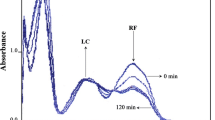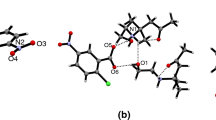Abstract
Purpose. This study examines the mechanism of hydrotropic solubilization using the riboflavin-nicotinamide system. The most commonly proposed mechanism for hydrotropic solubilization is complexation, and therefore, is investigated. Additionally, since nicotinamide and several other hydrotropic agents self-associate in aqueous solution, the possibility that self-association of the hydrotropic agent is important mechanistically is examined by studying the effect of temperature on hydrotropic ability. Researchers have shown that the degree of self-association decreases with increasing temperature. Therefore, if temperature affects the solubilizing capacity of nicotinamide, self-association must be mechanistically significant.
Methods. The complexation hypothesis is tested by looking at nicotinamide's ability to quench riboflavin fluorescence and by examining changes in the UV/Vis spectrum of riboflavin upon addition of nicotinamide. The solubility of riboflavin in nicotinamide solutions as a function of temperature is determined to assess the impact of self-association on hydrotropicity.
Results. Nicotinamide does not alter the intrinsic fluorescence of riboflavin nor are changes indicative of complexation observed in the UV/Vis spectrum. Temperature does have an effect on the hydrotropic ability of nicotinamide. Specifically, as temperature increases, the solubilizing capacity of nicotinamide decreases.
Conclusions. Because nicotinamide is unable to quench riboflavin fluorescence, and does not produce significant spectral changes, complexation of nicotinamide and riboflavin does not occur. However, since increasing temperature causes a decrease in the hydrotropic ability of nicotinamide and in its degree of self-association, it is proposed here that the self-association of nicotinamide impacts the hydrotropic mechanism.
Similar content being viewed by others
REFERENCES
D. Attwood and A. T. Florence. Pharmacy and Biology., Chapman and Hall, New York, 1983.
A. D. Woolfson, D. F. McCafferty, and A. P. Launchbury. Int. J. Pharm. 34:17–22 (1986).
G. A. Braqzeau and H. L. Fung. J. Pharm. Sci. 79:393–397 (1990).
D. E. Guttman and M. Y. Althalye. J. Am. Pharm. Assoc. (Sci. Ed.) 49:687–691 (1960).
R. A. Harte and J. L. Chen. J. Am. Pharm. Assoc. (Sci. Ed.) 38:568–570 (1949).
S. P. Shah and D. R. Flanagan. J. Pharm. Sci. 79:889–892 (1990).
S. A. Ibrahim, H. O. Ammar, A. A. Kasem, and S. S. Abu-Zaid. Pharmazie 34:809–812 (1979).
N. K. Jain, V. V. Patel, and L. N. Taneja. Pharmazie 43:194–196 (1988).
D. V. Frost. J. Am. Chem. Soc. 69:1064–1065 (1947).
J. Boylan. Liquids. In: L. Lachman, H. A. Lieberman, and J. L. Kanig (eds.) The Theory and Practice of Industrial Pharmacy. 3rd ed. Lea and Febiger. Phila. PA. 1986, p. 246.
S. Ueda. Chem. Pharm. Bull. 14:39–45 (1996).
D. Guttman and T. Higuchi. J. Am. Pharm. Assoc. (Sci. Ed.) 46:4–10 (1957).
A. L. Thakkar, L. G. Tensmeyer, and W. L. Wilham. J. Pharm. Sci. 60:1267–1269 (1971).
D. Attwood and O. K. Udeala. J. Pharm. Sci. 65:1053–1056 (1976).
A. M. Saleh, L. K. El-Khordagui, and A. T. Florence. Arch. Pharm. Chem. (Sci. Ed.) 14:64–68 (1986).
W. N. Charman, C. S. C. Lai, B. D. Finnin, and B. L. Reed. Pharm. Res. 8:1144–1150 (1991).
B. Birdsall, J. Feeney, and P. Partington. J. Chem. Soc. Perkin Trans. 2:2145–2151. (1973).
F. Kopecký, M. Vojteková, and M. Bednárová-Hyttnerová. Coll. Czech. Chem. Comm. 43:37–46 (1978).
M. A. Hussain, R. L. DiLuccio, and M. B. Maurin. J. Pharm. Sci. 82:77–79 (1993).
J. Truelove, R. Bawarshi-Nassar, N. R. Chen, and A. Hussain. Int. J. Pharm. 19:17–25 (1984).
A. A. Rasool, A. A. Hussain, and L. W. Dittert. J. Pharm. Sci. 80:387–393 (1991).
A. X. Chen, S. W. Zito, and R. A. Nash. Pharm. Res. 11:398–401 (1994).
R. A. Kenley, S. E. Jackson, J. S. Winterle, Y. Shunko, and G. C. Visor. J. Pharm. Sci. 75:648–653 (1986).
Y. E. Hazma and A. N. Paruta. Drug Dev. Ind. Pharm. 11:1577–1596 (1985).
R. E. Coffman and D. O. Kildsig. unpublished results.
M. A. Slifkin Biochim Biophys. Acta. 103:365–373 (1965).
D. A. Skoog. Principles of Instrumental Analysis. 3rd ed. Saunders College Publishing. Phila, PA., 1985, p. 207.
Author information
Authors and Affiliations
Rights and permissions
About this article
Cite this article
Coffman, R.E., Kildsig, D.O. Hydrotropic Solubilization— Mechanistic Studies. Pharm Res 13, 1460–1463 (1996). https://doi.org/10.1023/A:1016011125302
Issue Date:
DOI: https://doi.org/10.1023/A:1016011125302




